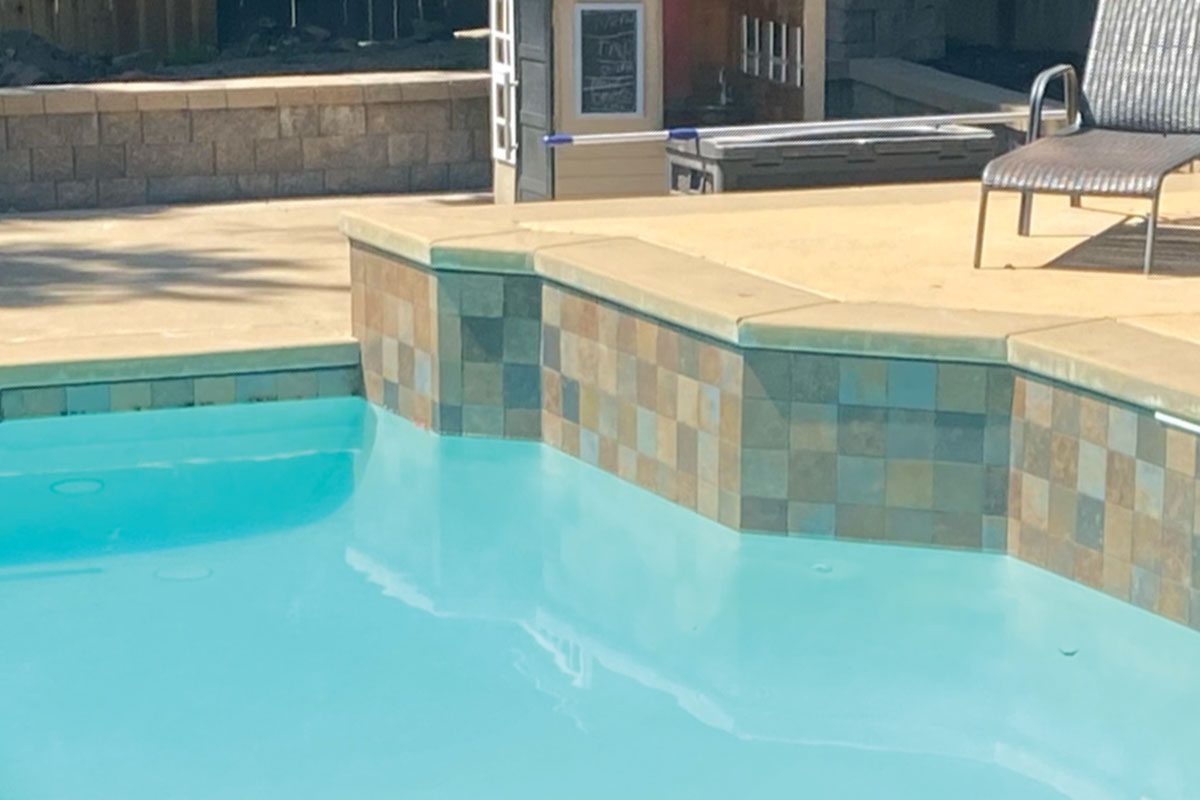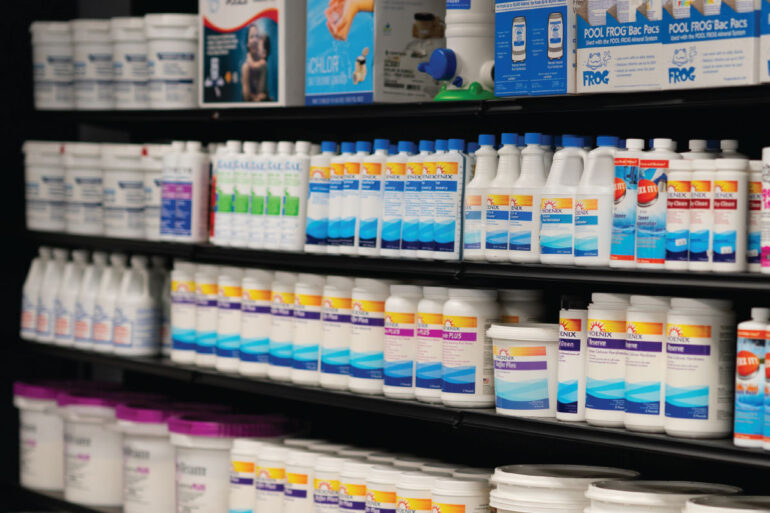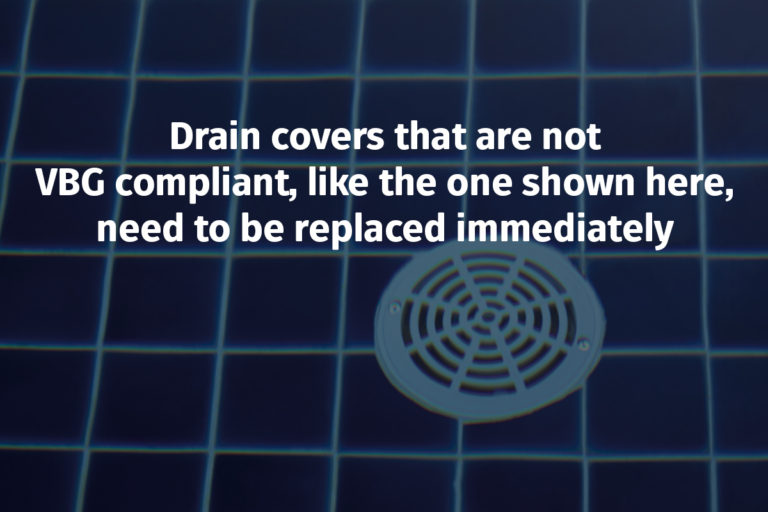Finish-Saving MicroGlass

MicroGlass densifier can save time, money and headaches for service companies
If you’re in the pool industry, you’ve undoubtedly heard of products that sound too good to be true. MicroGlass could fall into that category, but Patrick Brindle, MicroGlass director of business development, is careful to point out that while it may feel like magic, it’s just science.
“When you’re pitching the product to a potential customer they ask, ‘Does it really work?’ ” Brindle says. “Their whole outlook changes once they understand all we’re doing is protecting their pool by getting a densifier to strengthen the cement-based interior finish.”
MicroGlass protects new and existing finishes — it works on marcite, quartz, pebble and polished finishes. For an existing pool, MicroGlass is applied to the finish after it has been acid washed, rinsed with a sodium bicarbonate solution, pressure washed and allowed to dry. Depending on the pool, it may be appropriate to polish it or do extra stain mitigation. The MicroGlass can be sprayed using a fine mist sprayer, then backrolled to ensure even distribution.
MicroGlass is applied at a 5-star resort pool
“We’re changing the soluble calcium hydroxide in the cement,” says Alan Smith, MicroGlass chairman of the board. He adds that 25% of the makeup of hydrated cement is calcium hydroxide, which is very soluble, meaning it dissolves in pool water. “What our product does is convert [the calcium hydroxide] to a silicate, which is a glass-like product.”
The cement binder becomes an insoluble silicate, which makes the finish resistant to the damaging effects of the pool water. This makes stains easier to clean, keeps the pigment from degrading and prevents organics from being absorbed.
MicroGlass has been on the market for more than 15 years, but three years ago, MicroGlass approached Smith, the founder of Alan Smith Pools, to see if he’d like to try the product. Smith was initially skeptical, but after viewing the data and using it, he jumped aboard.


Jon Temple, owner of Tempool Inc., a plastering company in north Florida, has plastered tens of thousands of pools across the world, and he’s seen many products come and go. Before Temple uses anything on his customers’ pools, he tests and retests it. Three years ago he started in-house testing MicroGlass, first applying it on a top step to see if UV would impact it. Then he put it on plaster samples that were dropped into the bottom of a pool and put them through the ringer.
“We took the pH down to zero, the alkalinity down to zero,” Temple says. They also brought the chlorine up to 10 ppm and the cyanuric acid over 100 ppm. “We did all of that and it didn’t hurt [the samples].”
That was enough to get Temple to try it on some of his pools, but the testing didn’t end there. Next, they used MicroGlass on a newly plastered black pool and successfully completed a hot start up, without raising the calcium. “That told me the MicroGlass had sealed off that plaster enough to where the zero pH and zero alkalinity did not pull any calcium out of the plaster,” Temple says.
Levi Enochs, who owns the Premier Pool Service franchise in Gulfport, Mississippi, started using MicroGlass in January. In addition to service and remodeling, his company does the start ups, pool schools and warranty work for the Premier Pools & Spas builder in the area.
“I get my hands on a ton of pools,” Enochs says. “Plaster is an imperfect product, and things happen to it, especially if you’re not [keeping the water balanced]. It’s a headache for me. It’s a headache for the builder.”
When it comes to stains and scaling, MicroGlass has been a big help, Enochs says.
He recalls one customer had terrible fill water and he was constantly trying to mitigate stains.
“It got to the point where I was putting stain remover in the pool, and it was not coming out,” Enochs says. He drained it, prepped the pool and applied the MicroGlass. “It’s not going to prevent staining, but it helps remove the stains easier. I haven’t heard a complaint from them since we’ve done it.”
Enochs has started using MicroGlass on all of his pool remodels. He also has several customers who want him to apply it to their existing, fairly new pools in the winter to help their plaster stay nice longer.
Temple now buys MicroGlass by the pallet (and is going through one to two pallets a month), which he says is his final stamp of approval. As pool builders turn to service professionals to complete the start up of their new pools, Temple says MicroGlass opens a whole new revenue stream for the service sector. He includes it in all the industry trainings that he offers, 40% of which were for pool service companies last year.
“Plasterers can do a beautiful pool plaster,” Temple says. “Then they ruin it with a 20-minute acid wash. Then the service people are getting the blame for a bad start up.” Temple proposes that after plastering, service companies do the acid wash, bicarb rinse and MicroGlass. “They’re doing that start-up for 30 days — it gets their foot in the door to keep going and maintain that pool.”
Brindle says adding MicroGlass to your service offering can empower the pool service industry to help solve problems instead of just leaving them to fix imperfections.
Temple’s company doesn’t typically service pools after plastering them but will in particular circumstances. They’ve used those service accounts to give MicroGlass a final test and found that their MicroGlass pools use significantly less chemicals.
“That is a huge savings for the maintenance people if they’re charging a monthly fee plus chemicals or if they’re included,” Temple says.
For service companies, MicroGlass offers not only a new revenue stream but also the chance to exceed customers’ expectations and save them from potential large remodeling costs.
Before joining MicroGlass, Tom Cruz, national sales rep for the company, co-owned a pool renovation company and started using the product on his pools.
“What if a pool is not that bad?” Cruz asks, noting pools that may just have some color masking and don’t look as pretty anymore, but still have a lot of life in them. “We were a full remodel company, so I told customers ‘Here’s a $25,000 dollar remodel for everything new’, which is common for Northern California. That would take four to five weeks, including construction permits and time constrains. Or, in 24 hours for 80% less, I can have your pool looking close to brand new, much stronger and extend the pool’s service life with MicroGlass.’ ”
Of course, at some point even MicroGlass can’t save a failing pool. Brindle says they never want to overpromise and underdeliver.
“We want to make sure that we’re giving realistic expectations about what can and can’t salvage,” he says.
Temple also stresses that proper prep work is of the utmost importance for MicroGlass to be effective and that it should only be used on top of the finish, not in the concrete mix.
For Enochs, the added revenue is great, but the real value is in what it saves him.
“It eliminates so much stress for me,” he says. “It’s going to get rid of so many headaches for me. And it’s not even my pool. So if it’s doing that for me, it’s definitely going to for the homeowner.”






